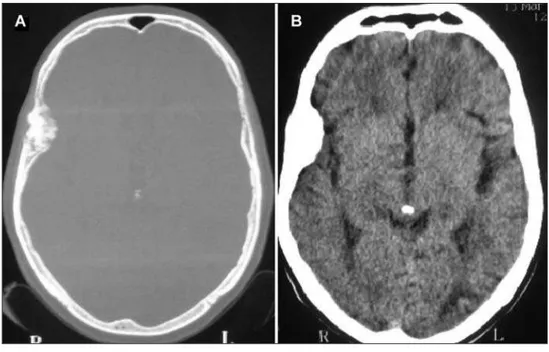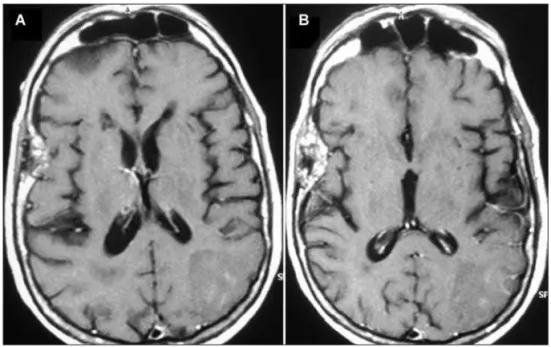Arq Neuropsiquiatr 2008;66(3-A):569-571
569
Clinical / Scientiic note
PRIMARY HEMANGIOMA OF THE SKULL
Baltazar Leão Reis¹, Gervásio Teles Cardoso Carvalho², Atos Alves de Sousa²,
Warley Barbosa de Freitas¹, Rafael Augusto Castro Santiago Brandão¹HEMANGIOMA PRIMáRIO dO CRâNIO
1Resident, Neurosurgery Service, Santa Casa de Belo Horizonte, Belo Horizonte MG, Brazil; 2MD, Neurosurgery Service, Santa Casa de Belo Horizonte and Faculdade de Ciências Médicas, Minas Gerais, Brazil.
Received 5 December 2007, received in inal form 10 April 2008. Accepted 15 May 2008
Dr. Baltazar Leão Reis – Rua Romano Stochiero 34/701 - 30130-120 Belo Horizonte MG - Brasil. E-mail: baltazarleao@yahoo.com.br Hemangiomas are benign vascular tumors that may
in-volve any part of the body. Primary osseous hemangiomas occur more frequently in the spine and less commonly in the skull. Toynbee 18451 was the author of the irst report
in English, a case of hemangioma of the skull bones. We report a rare case of skull cavernous hemangioma that was considered initially as prostate tumor metastasis.
CASE
In February 2007, a 73-year-old white man had a sudden on-set of dizziness and reading dificulty. He was on drug treatment for arterial systemic hypertension, and had undergone surgical treatment for prostate malignancy eight years previously, with seemingly adequate control. Computed tomography (CT) (Fig 1) and magnetic resonance imaging (MRI) (Fig 2) showed an isch-emic area on the left occipital region and an intraosseous ex-pansive lytic lesion on the right frontotemporal region, with-out signs of brain tissue involvement. There were no symptoms attributable to the osseous lesion. The hypothesis was a meta-static lesion from the prostate tumor.
In March 2007, he underwent right frontotemporal craniec-tomy with en bloc resection of the osseous lesion, followed by cranioplasty with acrylic cement.
Histopathology of the surgical sample showed primary os-seous cavernous-type hemangioma.
dISCUSSION
Hemangiomas are benign vascular neoplastic disor-ders. Histopathology classiies hemangiomas as venous, cavernous, and capillary, according to the predominant vascular network2. Although cavernous hemangiomas
more often involve the brain parenchyma, skull bones may also be affected. Intraosseous hemangiomas are relatively rare, and the spine is the most commonly involved site, followed by the skull bones. Hemangiomas of the skull represent 0.2% of all osseous tumors2-4, and 10% of all the
benign tumors of the skull2,3.
In a review undertaken by Heckl and coworkers5,
cov-ering the period from 1975 to 2000, cavernous he man-giomas of the skull involved the frontal, temporal, and
Arq Neuropsiquiatr 2008;66(3-A)
570
Hemangioma of the skull Reis et al.
parietal bones, in decreasing order. In another review, un-dertaken by Barnes6 in 1985, the frontal bone was also the
most frequently involved site, followed by the parietal bone and the zygomatic process.
Our patient had right frontotemporal involvement. Although cavernous hemangiomas of the skull are more prevalent in middle-aged women2, the exact
gen-der distribution has not been clearly established. Intraos-seous cavernomas are extremely benign, slow-growing, mostly asymptomatic tumors2. The main complaint is an
aesthetic embarrassment, sometimes a mass effect being
present. Patients may rarely present with an associated epidural hematoma or subarachnoid hemorrhage2.
Hemangiomas tend to be solitary lesions, but there have been reports of widespread body involvement, a situation termed angiomatosis7.
Skull radiography usually shows lytic lesions with scle-rotic borders and a “honeycomb” appearance2.
CT is an excellent investigation, as it allows detailed characterization of the cortical and trabecular bone to be made8. Although the appearance on CT may vary, an
expansive lesion with thin borders and intact internal and Fig 2. (A) Nonenhanced T1- weighted
MRI showing a right frontotemporal osseous lesion and an ischemic area on the left occipital region. (B) Gad-olinium-enhanced T1- weighted MRI showing heterogeneous uptake by the osseous lesion, a inding pointing to a vascular origin.
Arq Neuropsiquiatr 2008;66(3-A)
571 Hemangioma of the skull Reis et al.
external skull plates is the most common inding8,9.
Ac-cording to Heckl and coworkers5 external plate erosion,
associated with external tumor expansion, and preserva-tion of he internal plate are the most common radiologi-cal indings. Yet, in our case there was obvious erosion of the internal plate, with more prominent tumor exten-sion to the inside of the skull, but without any direct or indirect mass effect on the brain. The external plate was also eroded, but without signiicant alteration of the skull outline.
MRI investigation is important because of its potential to show soft tissue lesions9. MRI signal intensity depends
on the amount of venous stasis in the lesion and also on the rate of transformation of red marrow into yellow mar-row. While T1-weighted sequences may give high or low intensity signals, water-sensitive sequences, such as T2 and FLAIR, commonly give high intensity signals8. Banerji and
coworkers10, in 1994, suggested that early focal contrast
uptake by the lesion, with subsequent diffusion to the entire affected area, would be characteristic of osseous angiomas. Because it can identify relative changes in the lesion blood low (a vascular blush, for example), MRI may also suggest the vascular nature of the lesion11 (Fig 2).
Cerebral angiography is important for surgical plan-ning of smaller lesions and embolization of larger ones. Local vascularization increase and the feeding pedicles, without a large draining vein, may be identiied5. In some
cases, angiography fails to distinguish the feeding vessels, but when they are identiied, the middle meningeal artery and the supericial temporal artery are the most com-monly involved vessels2,12.
Although surgery is the treatment of choice, it is not al-ways necessary. Indications for surgery include: correction of compressive effects, hemorrhage control, and aesthetic improvement8, besides cases like ours, in which a
metastat-ic lesion is an important differential. En bloc resection of the lesion reduces the risk of bleeding, always potentially high in these tumors. Relapse is rare when adequate safety margins are observed. Curettage and irradiation are oth-er thoth-erapeutic options. In most cases, isolated curettage does not afford full tumor removal, relapses being more frequent. This technique is also associated with excessive bleeding, besides making adequate hemostasis more dif-icult to achieve13. Radiotherapy must be considered
when-ever surgical access is dificult and as a complement to subtotal resections14. In keeping with the most widely
rec-ommended technique, we opted for a craniectomy with en bloc resection, keeping a small safety margin. We then performed cranioplasty with acrylic cement.
On histopathology, cavernous hemangiomas consist of a well-deined, nonencapsulated mass, composed of large fully or partially blood-illed cavernous vascular spaces, separated by scant connective tissue. Intravascular throm-bosis with associated dystrophic calciication may also be seen3,7 (Fig 3).
In conclusions, primary osseous hemangioma of the skull is a rare benign lesion of vascular origin. Because the imaging indings are not speciic, preoperative diag-nosis is dificult, histopathology being essencial. Surgery is indicated to differentiate it from metastasis, or when there are aesthetic or compressive issues. En bloc resec-tion must be attempted, because relapse is rare when this surgery is successful.
REFERENCES
1. Toynbee J. An account of two vascular tumors developed in the sub-stance of bone. Lancet 1845;2:676.
2. Politi M, Romeike BF, Papanagiotou P, et al. Intraosseous hemangio-ma of the skull with dural tail sign: radiologic features with patholog-ic correlation. AJNR Am J Neurorradiol 2005;26:2049-2052.
3. Liu JK, Burger PC, Harnsberger HR, Couldwell WT. Primary intraos-seous skull base cavernous hemangioma: case report. Skull Base 2003;13:219-228.
4. Sargent EN, Reily EB, Posnikoff J. Primary hemangioma of the skull: case report of an unusual tumor. Am J Roentgenol 1965;95:874-879. 5. Heckl S, Aschoff A, Kunze S. Cavernomas of the skull: review of the
lit-erature 1975-2000. Neurosurg Rev 2002;25:56-62, discussion 66-67. 6. Barnes L. Solitary hemangioma of bone. In Barnes L (ed) Surgical
pa-thology of the head and neck, vol 1. New York: Dekker 1985:932-936. 7. Cotran RS, Kumar V, Collins T. Robbins, pathologic basis of disease, 6th
Ed. Philadelphia: W. B. Saunders 1999.
8. Moore SL, Chun JK, Mitre SA, Som PM. Intraosseous hemangio-ma of the zigohemangio-ma: CT and MR findings. AJNR Am J Neurorradiol 2001;22:1383-1385.
9. Amaral L, Chiurciu M, Almeida JR, Ferreira NF, Mendonça R, Lima SS. MR imaging for evaluation of lesions of the cranial vault. Arq Neurop-siquiatr 2003;61:521-532.
10. Banerji D, Inao S, Sugita K, Kaur A, Kumar D. Primary intraosseous orbital hemangioma: a case report and review of the literature. Neuro-surgery 1994;35:1131-1134.
11. Kumar S, Grupta S, Puri V, Mehndiratta MM, Malhotra V. Intradiploic hemangioma of skull bone. Indian Pediatr 1993;30:399-401
12. Bastug D, Ortiz O, Schochet SS. Hemangiomas in the calvaria: imaging
indings. AJR 1995;164:683-687.
13. Peterson DL, Murk SW, Story JL. Multiple cavernous hemangiomas of the skull: report of a case and review of the literature. Neurosurg 1992;30:778-782.

